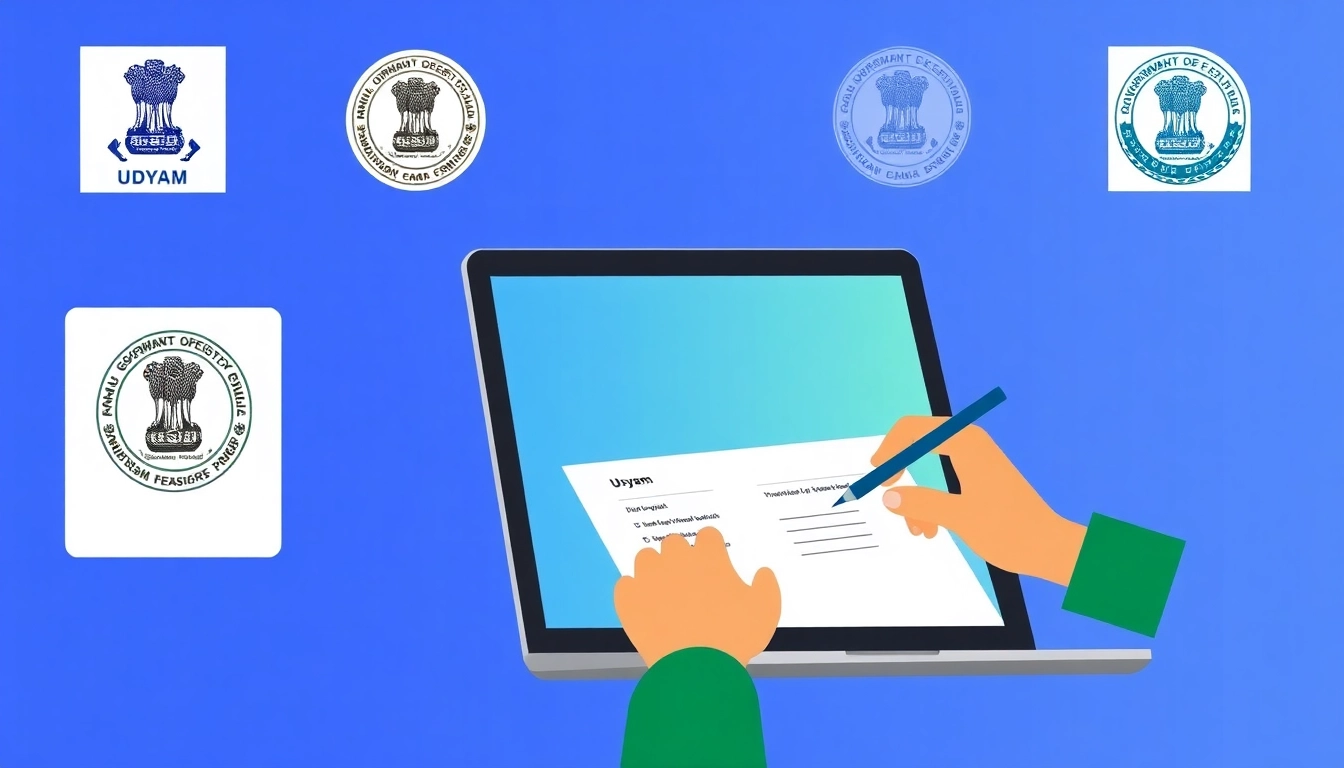Understanding Udyam Registration: Benefits and Overview
In today’s dynamic business landscape, registering your Micro, Small, or Medium Enterprise (MSME) is a crucial step toward growth, credibility, and access to government benefits. Among the various registration options available in India, udyam registration stands out as a streamlined, comprehensive process designed to facilitate entrepreneurs in establishing their enterprises with ease. This article explores the comprehensive aspects of Udyam registration, guiding you through its significance, benefits, registration procedures, troubleshooting, and ways to maximize its potential for your business growth.
What is Udyam Registration and Why It Matters
Udyam Registration is an official government system introduced by the Ministry of Micro, Small & Medium Enterprises in India. It serves as a formal registration process that classifies MSMEs based on their investment and turnover. Unlike earlier registration processes like Udyog Aadhaar, the Udyam system consolidates multiple registration schemes into a single portal, simplifying the process for entrepreneurs.
This registration is vital because it provides access to a range of government schemes, subsidies, and financial benefits designed to promote small businesses, foster innovation, and contribute to economic development. It also enhances the credibility of MSMEs, making it easier for them to access loans, contracts, and other privileges.
For entrepreneurs like Lokesh Rawat from Madhya Pradesh, who recently applied for an MSME Certificate, understanding the importance of Udyam registration can be a game-changer in expanding business opportunities and ensuring compliance with government policies.
Key Benefits for MSMEs and Entrepreneurs
1. Access to Subsidies and Schemes
Registering as an MSME under Udyam enables companies to avail themselves of various government schemes such as subsidies on interest rates, technology upgrades, and marketing support. The registration acts as a gateway to government initiatives like the Credit Guarantee Fund Trust and various export assistance programs.
2. Easier Loan Approvals
Financial institutions often prioritize MSMEs with valid Udyam registration. A verified certificate increases the chances of securing loans at favorable terms, with reduced collateral requirements, and faster processing times. Banks and NBFCs recognize Udyam certificates as proof of formal enterprise registration, reducing due diligence hurdles.
3. Tax and Regulatory Benefits
MSMEs registered under Udyam can enjoy benefits like exemption from certain local taxes, lower rates of Goods and Services Tax (GST), and simplified compliance requirements. This streamlines financial management and reduces operational costs.
4. Enhanced Market Credibility
Having an official Udyam certificate elevates the business’s profile, enhancing trust among customers, suppliers, and potential partners. It validates your enterprise’s legal status in the marketplace and opens pathways to government procurement and e-marketplace participation.
5. Priority in Government Tenders
Many government contracts and tenders prioritize MSMEs with valid registration, giving your enterprise a competitive edge. This can lead to increased business volume and reputation expansion.
6. Better Business Data Management
The Udyam portal maintains a centralized database, enabling better monitoring of MSME data, which is useful both for government policy-making and for businesses tracking their growth metrics.
Difference Between Udyog Aadhar and Udyam Registration
Historically, Udyog Aadhar was introduced as a self-declaration-based registration to recognize MSMEs. However, the government transitioned to Udyam registration to create a more integrated, single-window platform. Major differences include:
- Registration Process: Udyog Aadhar involved a simple registration process with minimal documentation, whereas Udyam registration is also online but emphasizes a more structured verification process.
- Data Consolidation: Udyam consolidates multiple schemes, providing a comprehensive profile of MSMEs with unique Udyam Registration Numbers (URNs).
- Inclusion Criteria: Udyam emphasizes the classification of MSMEs by investment and turnover, aligning with broader economic policies.
- Validity & Re-Registration: Udyam certification is valid lifetime after initial registration, reducing the need for re-registration compared to the Udyog Aadhar system.
In essence, Udyam registration is a more robust, trusted, and government-endorsed process, fostering transparency and ease of business for MSMEs across India.
Step-by-Step Process to Register for Udyam Online
Preparing Required Documents and Information
Before initiating the registration, ensure you have the following information and documents ready:
- Aadhaar Number: Linked with the entrepreneur’s bank account and PAN (Permanent Account Number).
- Business Details: PAN card, address proof of the enterprise, and bank details.
- Business Structure Details: Whether it is proprietorship, partnership, or private limited company.
- Investment & Turnover Figures: Estimated or actual data relating to your enterprise’s investment and annual turnover.
- Specifications for business activity: Nature of enterprise—manufacturing, service, or trading.
Having these details in order ensures a smooth registration process, reduces errors, and facilitates prompt approval.
Filling Out the Udyam Registration Form
The registration process is online via the official portal (udyam registration)). Follow these steps:
- Visit the official Udyam Registration portal.
- Click on “For New Registration” and select your enterprise type (Manufacturing or Service).
- Enter your Aadhaar number and validate it using OTP or digital signature.
- Fill in your business details—name, PAN, address, bank account number, and other required fields.
- Provide investment and turnover details—ensure accuracy for classification purposes.
- Review all entered information carefully for consistency and correctness.
- Submit the form to initiate registration.
Submitting and Verifying Your Udyam Certificate
Once submitted, the system processes your data, and you will receive an acknowledgment with a unique Udyam Registration Number (URN). The validation process generally takes a few hours to a couple of days. After successful verification, your Udyam Certificate is generated, which can be downloaded directly from the portal.
It’s important to verify the details on your certificate to ensure accuracy. In case of discrepancies or mistakes, you can update or re-verify your details through the portal.
Common Challenges and Troubleshooting Tips
How to Correct Errors During Registration
If you encounter errors such as mismatched data, technical glitches, or validation failures during registration:
- Double-check the entered Aadhaar number and other details for accuracy.
- Ensure your Aadhaar is seeded with the correct mobile number for OTP verification.
- Clear browser cache or try a different browser.
- Contact support through the portal’s helpdesk or customer service if issues persist.
Migration from Udyog Aadhar to Udyam
Existing Udyog Aadhar holders can migrate to Udyam to enjoy continued benefits and lifetime validity. The migration process is straightforward:
- Visit the Udyam registration portal.
- Select the “Existing Registration” option.
- Enter your Udyog Aadhar number and mobile OTP for validation.
- Confirm and submit your details for migration. Your previous registration will be automatically linked, and your Udyam certificate will be issued.
Understanding Re-Registration and Certificate Updates
While Udyam certificates are valid lifelong, any change in business activity, address, or classification should be updated via the portal. Regular updates ensure compliance and access to latest schemes and benefits.
Maximizing the Benefits of Your Udyam Certification
Using Your Udyam Certificate for Loans and Subsidies
Your Udyam certificate acts as a critical credential when applying for bank loans, government subsidies, or participating in tenders. Many banks recognize it instantly, often reducing documentation and approval time. Ensuring your certificate remains current can unlock financial advantages, growth capital, and technology grants.
Registering for Other MSME Schemes
Beyond loans, Udyam registration facilitates access to schemes like technology upgradation, export support, and skill development programs. Keep an eye on official notifications to apply for schemes suited to your enterprise’s needs.
Maintaining and Updating Your Business Details
It is vital to periodically review your MSME details on the portal. Updating information such as turnover, address, and business activity keeps your benefits active and prevents any compliance issues.
Performance Tracking and Compliance
Monitoring Your Udyam Registration Status
The portal allows entrepreneurs to check verification status, download certificates, and view scheme updates. Regular monitoring ensures you are aligned with current benefits.
Ensuring Continued Eligibility and Benefits
Adherence to specified investment and turnover thresholds maintains your MSME classification. Non-compliance or false information can lead to de-registration or loss of benefits.
Resources for Support and Further Guidance
For ongoing support, entrepreneurs can access online FAQs, contact helpline support, or refer to detailed guides available on the official portal and trusted MSME advisory websites. Engaging with local MSME development centers can also provide personalized assistance.
Conclusion
Getting your Udyam registration is a strategic step that offers multiple advantages for your business. From simplifying compliance to unlocking government schemes, the process—when executed correctly—can be a significant catalyst for enterprise growth. By understanding each step and leveraging available resources, entrepreneurs can maximize the benefits of their certification, ensuring sustained success in a competitive landscape.


